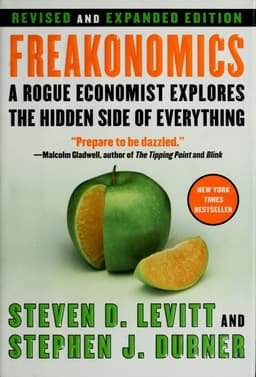
Freakonomics Book Summary
A Rogue Economist Explores the Hidden Side of Everything
Book by Steven D. Levitt, Stephen J. Dubner
Summary
Freakonomics is a rogue economist's exploration of the hidden side of everything, from cheating teachers and bizarre baby names to self-dealing realtors and crack-selling mama's boys, teaching you to question the world with data, dig deeper than conventional wisdom, and discern how people get what they want.
Sign in to rate
Average Rating: 5
The Hidden Side of Everything
The introduction lays out the central theme of Freakonomics - that economic analysis, when applied correctly, can reveal surprising truths about how the world really works by studying incentives. Incentives are at the core of modern life and understanding them allows us to view the world through a new lens. The authors argue conventional wisdom is often wrong and that it takes a novel way of looking at things to uncover the real truth.
Section: 1, Chapter: 1
The Power Of Incentives
The introduction provides a preview of some of the controversial topics the book will explore, including:
- How sumo wrestlers sometimes throw matches for financial gain
- How some teachers cheat on standardized tests to improve their school's ranking
- How a street crack gang operates similarly to a McDonald's franchise
- How the infamous Ku Klux Klan operates similarly to a group of real estate agents
The common thread is that incentives drive behavior, sometimes in unexpected ways. The tools of economics can shine a light on hidden truths when applied correctly.
Section: 1, Chapter: 1
Understanding How Incentives Can Backfire
The chapter opens with a case study of an Israeli day-care center that started charging a fine for parents who picked up their children late. Unexpectedly, the number of late pickups increased significantly after the fine was introduced. The authors argue this is because the fine removed the moral incentive to show up on time (not wanting to inconvenience the teachers) and replaced it with a relatively low monetary fine that parents were willing to pay.
This illustrates how incentives can sometimes backfire if not designed properly. It's critical to consider all the potential consequences, including unintended ones, when creating an incentive scheme.
Section: 1, Chapter: 1
The Dangers Of High-Stakes Testing
A significant portion of Chapter 1 is dedicated to exploring how high-stakes standardized testing can lead to cheating by teachers and administrators. As school rankings, funding, and teacher pay started being tied to test results in the 1990s, some teachers began manipulating results by:
- Giving students correct answers during the test
- Filling in answers themselves after the test
- Selectively reporting results from certain students
Mathematical analysis by the authors uncovered cheating in around 5% of classrooms per year in the Chicago Public School system. This shows how incentive schemes can be exploited when the stakes are high enough.
Section: 1, Chapter: 1
"Incentives Are The Cornerstone Of Modern Life"
"An incentive is simply a means of urging people to do more of a good thing and less of a bad thing... There are three basic flavors of incentive: economic, social, and moral. Very often a single incentive scheme will include all three varieties. Think about the anti-smoking campaign of recent years. The addition of a $3-per-pack 'sin tax' is a strong economic incentive against buying cigarettes. The banning of cigarettes in restaurants and bars is a powerful social incentive. And when the U.S. government asserts that terrorists raise money by selling black-market cigarettes, that acts as a rather jarring moral incentive."
Section: 1, Chapter: 1
Exposing Cheating Among Sumo Wrestlers
The chapter concludes with a detailed exploration of match rigging in professional sumo wrestling in Japan. The authors examined data from sumo tournaments and found that wrestlers who entered their final match with a 7-7 record (needing a win to secure promotion) won around 80% of the time against opponents with an 8-6 record (who had less on the line). However, in following tournaments, those 7-7 wrestlers lost 80% of rematches against the same opponents they previously beat.
This provides strong statistical evidence of match fixing among sumo wrestlers. Wrestlers were likely trading wins when they needed them with the promise of returning the favor in the future. Despite sumo's sterling reputation as an honorable sport, the incentives to cheat for personal gain were too strong to resist for many wrestlers.
Section: 1, Chapter: 1
Stetson Kennedy - The Man Who Infiltrated The KKK
Chapter 2 tells the story of Stetson Kennedy, a man who went undercover to infiltrate the Ku Klux Klan in the 1940s. Kennedy grew up in a well-to-do Florida family but was disturbed by the racial and social injustice he saw around him. He decided to join the KKK under a fake name to learn their secrets and expose their practices to the world.
Kennedy uncovered the Klan's complex secret rituals, language, and organizational hierarchy. He then shared this information widely, stripping away the Klan's mystique. Kennedy fed information to the writers of the popular Superman radio show, which featured Superman fighting the KKK. Details of the Klan's actual secret practices were woven into the show. This public disinfectant of the Klan's activities contributed to a steep decline in Klan membership in the late 1940s.
Section: 1, Chapter: 2
Information Asymmetry Exploited By Real Estate Agents
The authors argue that real estate agents utilize a similar information asymmetry as the KKK to further their own interests at the expense of their clients. An analysis of over 100,000 home sales in suburban Chicago showed that when real estate agents sell their own homes, they keep them on the market an average of 10 days longer and sell them for 3% more than comparable homes owned by their clients.
This is because agents have a strong informational advantage over their clients on market conditions, buyer interest, etc. But they only capture a small portion of incremental profits from a higher price on a client's home, so they have the incentive to sell it quicker even if that means a lower price. This is a prime example of an expert exploiting an information imbalance for personal gain.
Section: 1, Chapter: 2
Using Knowledge To Gain An Edge
The common thread between the KKK and real estate agents is information asymmetry - they both use specialized knowledge and privileged information to gain an edge over the general public.
- KKK members closely guarded their secret rituals, language, and practices to maintain an aura of mystery and menace that facilitated their intimidation tactics
- Real estate agents are privy to extensive data on home sales, buyer interest, market conditions, etc. that they can leverage to get better deals for themselves versus for their clients
In both cases, piercing the veil of secrecy can help level the playing field. When Stetson Kennedy exposed the KKK's secrets, it defanged the organization. And digital tools have made it easier for homeowners to get comparable sales data, reducing real estate agents' historical information advantage.
Section: 1, Chapter: 2
How The Internet Is Eroding Information Advantages
The chapter concludes by discussing how the internet is steadily eroding information imbalances in various industries:
- Travel websites like Expedia and Orbitz allow consumers to easily comparison shop for the best deals on airfare, hotels, rental cars, etc.
- Automotive websites like Edmunds and Kelly Blue Book enable car buyers to see the actual dealer cost for vehicles and view comparable sales data
- In the late 1990s, a federal law required funeral homes to disclose detailed price lists, weakening their ability to upsell grieving families on unnecessary add-ons
As information becomes more freely available online, the potential for experts to exploit their informational advantages will likely continue to decline. However, the authors note that information will always be power - the internet has just shifted more power to the masses.
Section: 1, Chapter: 2
The Myth Of The Wealthy Drug Dealer
Chapter 3 explores the economics of the illegal drug trade through the lens of a Chicago crack cocaine gang. Contrary to the common portrayal in popular media of the affluent drug kingpin, the data shows that the vast majority of street-level drug dealers earn very little and still live with their mothers. The typical crack dealer in the gang worked long, dangerous hours for only about $3.30 an hour - less than minimum wage.
Only the very top of the drug gang pyramid, perhaps 2-3% of the members, earned substantial incomes. This is similar to the extreme income inequality in corporate America, where the CEO and top executives earn vastly more than rank-and-file workers.
Section: 1, Chapter: 3
Why Drug Dealers Are Like McDonald's Franchisees
The authors compare the organizational structure and economics of the crack gang to that of McDonald's:
- Like McDonald's, the gang has a franchise-like model where regional managers ("board of directors") take a cut of profits from the local gang chapters they oversee
- The gang has a clear hierarchy and pay scale, with wages increasing at each level (though still meager for most)
- Workers at the bottom (drug dealers or burger flippers) earn the least but are the most visible to the public
- The promise of rising up the hierarchy motivates low-paid workers to stay loyal despite poor base pay
So while street-level crack dealing seems like a drastically different profession than fast food, the underlying business models and worker incentives are surprisingly similar. The allure of future riches entices the many to toil for low wages.
Section: 1, Chapter: 3
Drug Dealers Are Like Aspiring Authors And Actors
Most street-level drug dealers are not in it for the money - at least not the meager money they make today. Instead, like many aspiring authors, actors, and athletes, they are in it for the chance, however small, of making it big in the future.
The drug trade is like a "tournament" where dealers accept high risk and low wages in exchange for a slim shot at ascending the hierarchy and earning an outsized payoff. This helps explain why the drug trade can attract so many foot soldiers despite terrible base compensation. The average dealer may earn less than $4 per hour, but dreams of becoming the next Stringer Bell.
Of course, the vast majority will not ascend to the top, just like most authors won't become J.K. Rowling and most high school athletes won't go pro. But the small possibility is enough to motivate many to try.
Section: 1, Chapter: 3
The Invention Of Crack Cocaine As A "Disruptive Innovation"
The authors draw an analogy between the invention of crack cocaine in the 1980s and the invention of nylon stockings in the 1930s. Both innovations made a previously expensive luxury item (powder cocaine or silk stockings) much cheaper and more widely available.
Crack was like the "fast fashion" of the drug world - it democratized what had been an elite indulgence. Suddenly cocaine went from a premium product favored by the rich to an affordable mass market good. This unleashed a devastating wave of addiction, violence, and community destruction, especially in inner city neighborhoods.
The flood of cheap crack served as a disruptive innovation much like digital photography, MP3s, or e-books. It upended the market and brought both benefits (a less expensive alternative for consumers) and steep costs (decimated rivals and traditional institutions). The invention of crack created entirely new markets and reshaped the culture in profound ways.
Section: 1, Chapter: 3
The Mysterious Fall Of Crime In The 1990s
In the 1990s, crime fell precipitously across the United States. Violent crime plummeted 18% in the span of just three years from 1993-1996. This caught many experts by surprise, as the prevailing forecast at the time had been for a coming crime wave fueled by the crack epidemic and a rise of "superpredator" juvenile offenders.
So what explains the unexpected crime drop? The authors argue it was not the commonly cited reasons like innovative policing, stricter gun control, a stronger economy, or more use of capital punishment. While those may have played a role, the data suggests the real answer is a surprising one - the legalization of abortion 20 years prior, following Roe v. Wade. According to the authors, this was the hidden factor that quietly removed a large cohort of would-be violent criminals from the population.
Section: 1, Chapter: 4
"Abortion Leads To Less Crime"
"Our theory does not suggest that the legalization of abortion can account for all of the decline in crime. Clearly, many other factors may also be at play: a strong economy, increases in the number of police, and the rising prison population, among them. But legalized abortion should not be overlooked. It was perhaps the single most important event of the last half century in leading to the abrupt and unexpected decline in crime that the United States has experienced."
Section: 1, Chapter: 4
Romania's Abortion Ban And Subsequent Crime Wave
To illustrate their theory that legalized abortion reduces crime, the authors point to Romania's experience under the dictatorship of Nicolae Ceaușescu. In 1966, Ceaușescu banned abortion in an effort to increase Romania's population. This new cohort of "unwanted" children, born into families that would have preferred not to have them, proved to have worse life outcomes. The post-ban cohort was:
- Less likely to finish school
- More likely to become unemployed
- More likely to commit crimes as adults
After Ceaușescu was overthrown in 1989, many of the impoverished, undereducated children born after the abortion ban were in their teenage years - the peak age for criminality. They went on to fuel a rapid rise in crime throughout the 1990s, the opposite of what was happening in the United States.
Section: 1, Chapter: 4
The Five Factors That Explain The 1990s Crime Drop
According to the authors, there were five key factors that drove the dramatic decline in U.S. crime in the 1990s:
- Increased incarceration - More criminals in prison meant fewer on the streets
- More police - A rising number of police per capita increased the risk of getting caught
- The end of the crack epidemic - Crack markets matured and violence subsided as dealers focused more on customer retention vs. turf wars
- Legalized abortion - Fewer unwanted pregnancies 20 years prior meant fewer children grew up in environments that incline one towards crime
- The strong 1990s economy - Economic growth and low unemployment made crime a relatively less attractive option
However, the authors argue the first four factors account for the lion's share of the crime drop, with abortion alone responsible for as much as 30% of the decline. Improved policing tactics and the innovative CompStat system rolled out in New York City, on the other hand, likely had little impact despite receiving significant media attention.
Section: 1, Chapter: 4
Why Many Common Theories For The Crime Drop Are Wrong
The authors debunk several popular theories for why crime fell so sharply in the 1990s:
- Tougher gun laws - Crime fell just as sharply in states without any changes to their gun laws, and the much-touted Brady Act only had a very modest impact
- Increased use of capital punishment - The death penalty is applied too infrequently to have a large impact, and crime fell even in states without capital punishment
- More innovative policing strategies - New York City's "broken windows" policing gets more credit than it likely deserves, as crime fell nationally even in cities that didn't adopt new policing tactics
- The strong economy - The link between economic conditions and violent crime is relatively weak and inconsistent, and the timing doesn't match up (crime was falling before the 1990s boom)
- Younger demographics - Demographic trends actually pointed towards a crime increase in the 1990s as the teenage share of the population rose
By process of elimination, the authors come back to legalized abortion, increased incarceration, more police, and the fading of the crack epidemic as the only factors that can really explain the magnitude and timing of the huge 1990s crime drop.
Section: 1, Chapter: 4
The Factors That Really Predict A Child's Success
What matters most in determining a child's success? According to the authors' analysis of data from the U.S. Department of Education, some factors are important:
- The child has highly educated parents
- The child's parents have high socioeconomic status
- The child's mother was 30 or older at the time of first child's birth
- The child's parents speak English in the home
- The child has many books in his home
Meanwhile, other factors that conventional wisdom might point to don't seem to matter:
- The child's family is intact
- The child's parents moved into a better neighborhood
- The child's mother didn't work between birth and kindergarten
- The child frequently watches television
- The child's parents read to him nearly every day
So what does this all mean? In general, the data suggests that factors related to who the parents are, their educational attainment and socioeconomic status, matter more than what parents specifically do.
Section: 1, Chapter: 5
High-Income Families Have More In Common Than Just Money
According to data from the National Longitudinal Survey of Youth (NLSY), a child from a high-income family will experience about 45% more time engaged in interactive activities with their parents - reading, museum visits, travel - compared to a low-income child by age 6. The nature of the interactions differ too:
- High-income parents use more complex language and complete more sentences
- High-income parents ask more open-ended questions to stretch a child's thinking
- High-income parents are more likely to practice "concerted cultivation" - orchestrating a child's free time to impart skills
So high-income families give their children different experiences and interactions from the start. These "investments" in early cognitive development likely play a key role in predicting later academic and economic success, beyond just the effects of money.
Section: 1, Chapter: 5
Good Parenting Might Not Be Enough To Overcome Bad Circumstances
The authors tell the story of two boys, one white and one black, to illustrate how much circumstances and environment matter regardless of parenting:
- The white boy grew up in suburban Chicago with encouraging, educated parents and a stable home environment. He excelled in school and was thought by teachers to be a math prodigy.
- The black boy grew up in the ghetto of Daytona Beach. His mother abandoned him, his father beat him, and he began selling drugs and carrying a gun by his teens.
On paper, the first boy should go on to great success while the second was likely headed for failure or imprisonment. But in fact, the opposite occurred. The white boy grew up to be Ted Kaczynski, the infamous Unabomber. And the black boy was Roland Fryer, the highly successful economist now professoring at Harvard.
The point is that even the best parenting intentions can be derailed by mental illness, trauma, or other uncontrollable factors. Good parenting improves a child's odds but doesn't guarantee the outcome.
Section: 1, Chapter: 5
A Child's Name Isn't Destiny, But It Isn't Meaningless Either
Chapter 6 explores the fascinating data around children's names and life outcomes. Some key findings:
- There is a strong socioeconomic pattern to name choices. "Loser" names like Amber, Heather or Travis are more common among low-education families, while high-education families prefer names like Alexandra, Benjamin, or Samuel.
- But the data shows no causal link between names and life outcomes. A baby named Amber doesn't have a worse life because of her name; rather, she was more likely born to low-education parents.
- While names don't seem to affect scores or grades, there is some evidence of name discrimination in the job market, with "white" names getting more callbacks than "black" names on identical resumes.
"Trendy" names favored by high-education parents today like Ava, Liam or Ezra may sound dated or lower-class in 20 years. Names are constantly evolving status markers.
Section: 1, Chapter: 6
How "Freakonomics" Analysis Uncovered California Baby-Naming Trends
The authors obtained an extraordinary data set from the California Department of Health Services covering every child born in the state between 1961-2000, over 16 million births. By analyzing the name, race, zip code, birth circumstances, and socioeconomic markers, the authors uncovered fascinating insights into baby naming:
- The same names are favored by high-income whites and low-income blacks at any given time, just with a multi-decade lag. "Prestige" names are consistent across race but inconsistent across time.
- Popular girls names cycle in and out of fashion much faster than boys names. Many top girls names from 1960 are fully out of fashion today, while top boys names are more likely to persist.
This analysis demonstrates the power of exploring large, unexpected data sets to gain insight into social and cultural trends. What people name their children is a telling window into their backgrounds, influences, and aspirations.
Section: 1, Chapter: 6
The Power Of The Unexpected Question
The real lesson of Freakonomics is the power of the unexpected question. By probing and measuring the hidden influences beneath surface-level truths, we gain genuine insight into how the world works.
Some questions tackled in the book:
- How are sumo wrestlers and teachers alike? (Both have strong performance incentives and both sometimes cheat to improve their metrics)
- Why did violent crime fall so suddenly in the 1990s? (The legalization of abortion decades earlier reduced the population of at-risk youth)
- What matters more - good parenting technique or who the parents are? (The data suggests the latter)
Pursued doggedly with data, they yield fascinating and actionable answers. Don't fear the obvious, to challenge conventional wisdom, and to follow the data trail wherever it leads. This is the essence of thinking like a freak.
Section: 1, Chapter: 7
Related Content
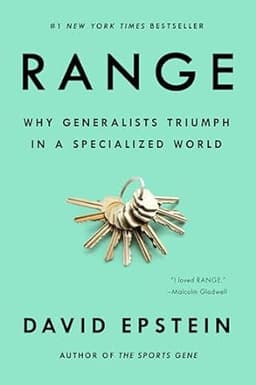
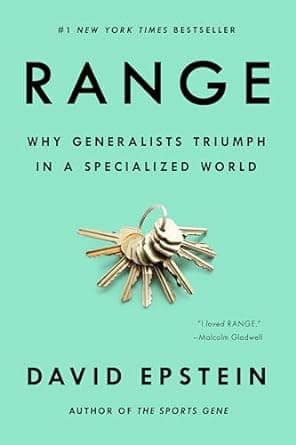
Range Book Summary
David Epstein
"Range" challenges the conventional wisdom that early specialization is the key to success. Instead, Epstein argues that in our increasingly complex and unpredictable world, it is those with broad experience and diverse skills who are best equipped to thrive.
"Range" challenges the conventional wisdom that early specialization is the key to success. Instead, Epstein argues that in our increasingly complex and unpredictable world, it is those with broad experience and diverse skills who are best equipped to thrive.
Personal Development
Learning
Psychology
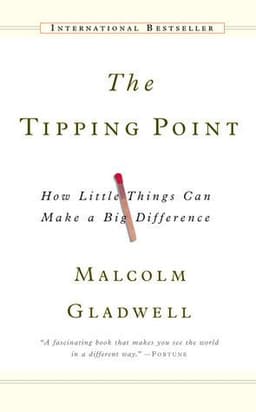
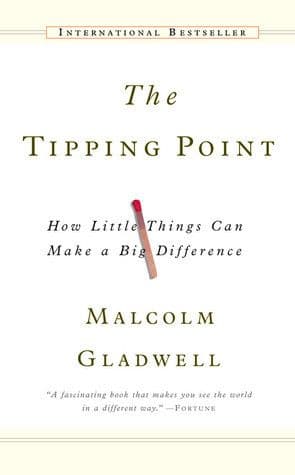
The Tipping Point Book Summary
Malcolm Gladwell
The Tipping Point reveals the hidden forces that cause social epidemics - from fashion trends to crime waves - to spread like viruses, and shows how to start and control positive epidemics of our own.
The Tipping Point reveals the hidden forces that cause social epidemics - from fashion trends to crime waves - to spread like viruses, and shows how to start and control positive epidemics of our own.
Psychology
Personal Development
Sociology
Economics

